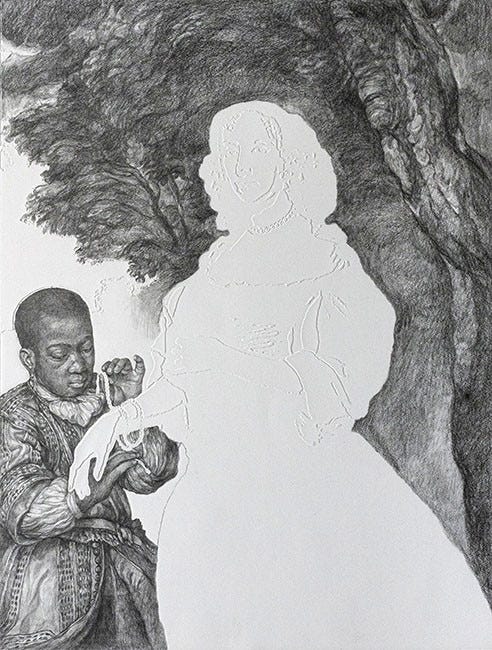In This Newsletter
Review: Ordinary Notes
More from Christina Sharpe: other work by the same author
Explore further: literature and media related to this month’s book

Black existence
Ordinary Notes is a collection of 248 notes by scholar Christina Sharpe, each ranging in length from a couple of lines to a couple of pages. The notes are organised into eight collections — the author has stated that most notes appear in the order they were written within each collection.
At the core of this work is the relationship with her mother, Ida Wright Sharpe, and her reflections on everyday Black existence, both in the present and the past. The transition from the twentieth to the twenty-first century reveals the burden of living within an atmosphere of intolerance and hate, causing a weathering effect.
"I write these ordinary things to detail the everyday sonic and haptic vocabularies of living life under these brutal regimes.” (Note #242, pg. 342)
Memories and remembrance are persistent themes running throughout the book. Time feels elastic, with past events ricocheting into the present, from the public (Folcroft, Pennsylvania, 1963 to Charlottesville, Virginia, 2017) to private (in an example of what she terms a “rehabilitated and reconstructed” set of recollections from a former high school classmate). A poignant reminder is felt in the connection she traces between the births and deaths of her parents juxtaposed against those popularly remembered as historical Black figures.
“My father was born in 1911.
My mother was born in 1923.
The proximity startles me. So close to slavery that when my father was two, Harriet Tubman was still alive. Time collapses in on itself; it is not linear; it is a boomerang” (Note #87, page 132)
The proximity of these dates forces me to reassess the boundaries between ancient and current histories, reminding me that the past is also present.
Erasure

I have deliberately chosen to resume my book review project with a title seemingly unrelated to design.
Before attempting any reflection on or critique of the nature of design or research, it feels more urgent to me to first reflect on the nature of being Black in a design industry that has been so effective at normalising the erasure of Black, Brown and Indigenous knowledge traditions and artefacts from the canon of what is collectively regarded as Design.
“So much of Black life and work and resistance goes missing. Black people work to hold all of this information in our heads, oftentimes unbolstered by institutions, oftentimes against such institutions' purposeful forgetting. We have to function as a living library: as an institution” (Note #185, pg. 260)
The roots of Modernism, which is central to how we collectively perceive “good design”, both professionally and pedagogically, have resulted in a set of universal ideals that mask how Modernism's architects sought to denigrate ”the ornament” — essentially a form of cultural subjugation through aesthetics.1
For the Black subject, erasure means noticing that the human on which design’s methods are centred are emblematic of a failure to engage with different knowledge traditions and knowledge at the margins. André Brock, a prominent scholar of Black Cyberculture, astutely observes how real-world marginality structures so much of how Black culture engages with technology:
“… technology use for Blacks often occurs from the margins of society, where survival, joy, and resistance intertwine uncomfortably in the everyday” (Distributed Blackness: African American Cybercultures, pg. 211)
Visibility
Returning to the central themes of erasure and remembrance, Ordinary Notes is a reassuring work to rest with, because of its unwavering gaze towards the Black subject.
This parallel struck me instantly when I saw Vanishing Point, a series by Barbara Walker currently at the Black Atlantic exhibition in Cambridge.

The lone Black figure is presented as a detailed graphite drawing, while the other subjects are transformed into a plain white embossing. By reversing the polarity of who is visible, I am forced to reflect on why this reversal is so unsettling.
“Tenderness might just be a gesture, it might just be a look, a Black look, some regard, relayed between people in peril” (Note 175, pg. 250)
Reading and re-reading Ordinary Notes helps me feel seen and reassures me that while the erasure of Black, Brown, and Indigenous knowledge traditions were past acts, their continued absences are in no way an inevitable path for the future.
Ordinary Notes by Christina Sharpe. Published in 2023 by Daunt Book Originals, 382 pages, £14.99
More from Christina Sharpe
Book: In the Wake by Christina Sharpe (Duke University Press, 2016, 192 pages)
Article: The Weather by Christina Sharpe (from The New Inquiry, 2017)
Video: Christina Sharpe, Loophole of Retreat: Venice (from Loophole of Retreat: Venice, 2023, 11 mins)
Explore further
Articles
Now You See It: Helvetica, Modernism and the Status Quo of Design by Jen Wang (from Pavvy Design Studio, 2019)
A New Bauhaus? The Debate for a More Inclusive Europe by Hicham Khalidi and Rolando Vázquez (from Rekto Verso, 2021)
Books
Distributed Blackness: African American Cybercultures by André Brock (New York University Press, 2020, 271 pages; also available as a free eBook under Open Access)
Race and Modern Architecture: A Critical History from the Enlightenment to the Present (chapter 7 “Structural Racialism in Modern Architecture Theory”, pages 134-150) edited by Irene Cheng, Charles L. Davis II and Mabel O. Wilson (University of Pittsburgh Press, 2020, 438 pages)
Exhibition
Black Atlantic: Power, People, Resistance at Fitzwilliam Museum, Cambridge (exhibition on until 7 January 2024, free entry)
Media
Summer School — Dr. Mabel O. Wilson, Architect and Scholar (from Institute of Black Imagination podcast, 7 June 2020 repeated on 23 July 2023, 1hr 11mins)
I will be examining the ideology of European Modernism in more detail in Fifteenth, my next newsletter, out on 15th December.



